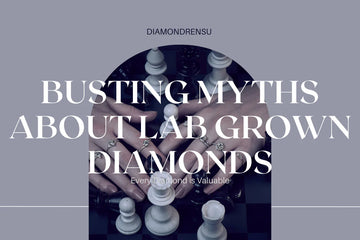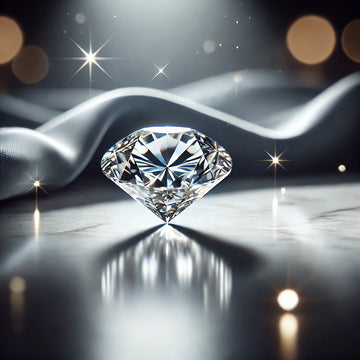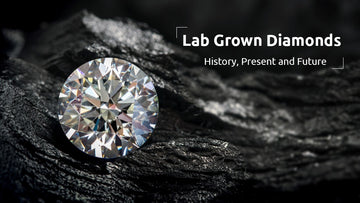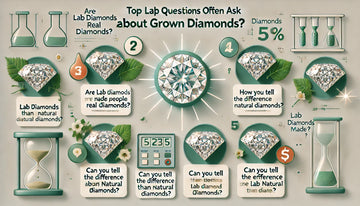
Myth 1: Lab Grown Diamonds Aren't Real Diamonds

The Truth:
First, there is a general misconception that lab grown diamonds are not the same as natural diamonds that has to be resolved. The United States of America is rather rich in this phenomenon. Between real diamonds and synthetic diamonds created in a laboratory, it is almost impossible to tell them apart.
These objects' physical characteristics, chemical content, and look have been discovered to be exactly like those of ground recovered diamonds. The results of the research have helped one to ascertain this. Not one thing stands out between the two that would be easy to pick out. At first in the relationship, they are the most unlike one another that you could fathom. Their first interaction with each other could be found at this point in time.
Natural diamonds arise deep inside the crust of the earth, during a time span spanning billions of years, and at very high temperatures. This method requires high temperatures to be implemented. Regarding the temperature and the pressure, the present circumstances are quite high throughout this process.
Conversely, laboratory grown diamonds are created in an environment under strict control utilizing contemporary technology methods meant to replicate natural environments. Manufacturing the diamonds in a lab helps one do this. This environment was created to enable diamond production.
| Diamond Property | Mined Diamond | Lab grown Diamond |
|---|---|---|
| Chemical Composition | C (crystalline Carbon) | C (crystalline Carbon) |
| Crystalline Structure | Cubic | Cubic |
| Refractive Index | 2.42 | 2.42 |
| Dispersion | 0.044 | 0.044 |
| Hardness | 10 | 10 |
| Density | 3.52 | 3.52 |
Myth 2: Lab Grown Diamonds Are Fake or Imitation

The Truth:
The second fallacy holds that most of the created diamonds in laboratories are either fakes or copies. This is so because many times laboratories create fake diamonds. Lab grown diamond are created from real materials; hence, it is not feasible to separate them from diamond samples like cubic zirconia or moissanite.
This is so because genuine elements produce artificial diamonds. It is impossible to do so in any way since it cannot distinguish between the two. Comprising carbon atoms organized in a crystalline form, they are on par with actual diamonds. The fact that they are made of carbon accounts for everything.
The structure of diamonds is the same one they possess inside their framework. Made in a lab and categorized as lab grown diamond, laboratory grown diamond are One class of diamond are lab grown. Conversely, mining methods help us obtain natural diamonds from the ground.
One of the main differences between natural diamonds and lab grown diamonds is the presence of this feature, which defines both kinds of diamonds. Natural diamonds are those obtained from the earth; so, the phrase "natural diamond" refers to those gems.
Myth 3: Lab Grown Diamonds Are of Inferior Quality
The Truth:
The third story holds that real diamonds are thought to be better than synthetic diamonds created in a lab. Lab generated diamonds have far more expenses. Lab grown diamond are well-known to have not only the same quality as natural diamonds but even better. One cannot argue in any way, shape, or form about the truthfulness of this topic. All things considered, this could turn out to be happening.
A correct simulation of the surroundings in which natural diamonds are found helps scientists lower the frequency of defects and impurities in natural diamonds. Real diamonds are discovered in the environment; hence, this is realistic. This procedure lowers the likelihood that natural diamonds will contain certain pollutants. Surrounding this location, one can find natural diamonds that can be unearthed here.
This helps them identify natural diamonds more frequently than they would be able to ascertain under any other condition. Given this, it is feasible for lab grown diamonds to show a very high degree of color purity. This is thus a result of this reality.
| Quality | Lab-Grown Diamonds | Mined Diamonds |
|---|---|---|
| Chemical Composition | Identical carbon structures (pure carbon) | Identical carbon structures (pure carbon) |
| Physical Properties | Same hardness (10 on Mohs scale), density, and refractive index | Same hardness (10 on Mohs scale), density, and refractive index |
| Appearance | Indistinguishable from mined diamonds to the naked eye | Indistinguishable from lab-grown diamonds to the naked eye |
Myth 4: Lab-Grown Diamonds Aren't Valuable
The Truth:
On the other hand, the fourth fallacy claims that lab grown diamonds have absolutely no worth whatsoever. The first mistake is not this; this is the reverse. Though their costs are usually lower than those of natural diamonds, the truth is that lab grown diamond are real. This is true even if lab grown diamonds are not almost as valuable as naturally occurring diamonds.
The main cause of the cost difference is the result, which is both a longer supply chain and less expensive manufacturing costs. This turns out to be the fundamental reason for the variation. Both of these aspects help to produce this long supply chain. This is the plausible explanation that could be credited; hence, one might attribute most of the cost variation to this one.
Lab grown diamonds are an excellent and affordable alternative to natural diamonds. Created in a controlled environment, these synthetic diamonds offer the same beauty and quality as natural ones.
| Aspect | Lab-Grown Diamonds | Mined Diamonds |
|---|---|---|
| Price | Typically 20-40% less expensive than mined diamonds | Generally more expensive due to extraction and supply chain costs |
| Quality Control | Can be produced with fewer imperfections and higher quality | Quality varies depending on the source and mining conditions |
| Environmental Impact | Lower environmental impact (no mining, less energy-intensive) | Higher environmental impact (mining, land disturbance, energy use) |
| Ethical Considerations | No associated human rights issues or conflict zones | Potential association with conflict zones and unethical labor practices |
| Availability | More readily available and customizable in terms of size and quality | Availability depends on mining yields and market supply |
Myth 5: Lab Grown Diamonds Are All Identical
The Truth:
Every single lab created diamond challenges the fifth illusion since it is flawless in every sense. Lab-grown diamond range in size and form much as naturally occurring diamonds do. They can also have a rather wide spectrum of unusual traits.
These unique features make lab grown diamond remarkable in comparison to natural diamond. Using the same standards as natural diamond, respected gemological laboratories grade lab grown diamond: the "4 Cs: cut, color, clarity, and carat weight". These criteria define the diamond quality.
Lab-grown diamond is graded using the same technique applied for natural diamonds. These qualities help the diamond industry evaluate the quality of their sold diamonds. Consequently, one should anticipate the same strict quality assurance when purchasing lab grown diamond as with natural diamonds.
| Fact |
|---|
| Lab grown diamonds can vary in terms of quality, size, color, and clarity, just like natural diamonds. Different production methods and technologies result in a range of characteristics and qualities. |
Frequently Asked Questions (FAQs)
What are lab grown diamonds?
Lab grown diamonds are real diamond created in a laboratory using advanced technological processes. They have the same physical and chemical properties as natural diamonds.
How can I tell if a diamond is lab grown?
Lab grown diamond can be identified through specialized equipment used by gemological laboratories. They often have microscopic laser inscriptions indicating their lab-grown origin, which can be verified with a loupe or microscope.
Are lab grown diamonds a good investment?
Lab grown diamonds offer excellent value for money and are a great choice for those looking for beautiful, ethical, and affordable diamonds. However, like most consumer goods, they may not appreciate over time like natural diamonds.
Do lab grown diamond have a resale value?
Lab grown diamond do have a resale value, though it may not be as high as that of natural diamonds. The resale market for lab-grown diamonds is still developing, but their popularity continues to grow.
Can lab grown diamond be insured?
Yes, lab grown diamond can be insured just like natural diamonds. Many insurance companies offer policies that cover lab-grown diamond jewelry.
Conclusion
Lab grown diamonds are an amazing and real substitute for naturally occurring diamonds. Understanding and clarifying these misconceptions allows you to make an informed choice. Lab grown diamond are a gorgeous, premium, and reasonably priced alternative suitable for engagement rings, gifts, and personal use. Embrace their brilliance and let their shine brighten your life.

 Engagement Ring
Engagement Ring  Anniversary Rings
Anniversary Rings Solitaire Rings
Solitaire Rings Halo Rings
Halo Rings Men's Ring
Men's Ring Toi Moi Ring
Toi Moi Ring Three Stone Rings
Three Stone Rings Nature Inspired Rings
Nature Inspired Rings Rose Cut Diamond Rings
Rose Cut Diamond Rings Fancy Color Rings
Fancy Color Rings Antique Cut Diamond Rings
Antique Cut Diamond Rings Wedding rings
Wedding rings All Lab Grown Diamond Ring
All Lab Grown Diamond Ring Engagement Ring
Engagement Ring  Three Stone Rings
Three Stone Rings Daily Wear
Daily Wear Fancy Color Rings
Fancy Color Rings Antique Cut Diamond Rings
Antique Cut Diamond Rings Earrings
Earrings Bracelet
Bracelet Pendent
Pendent Necklace
Necklace Rings
Rings Earrings
Earrings All Rainbow Collection
All Rainbow Collection Tennis chain
Tennis chain Custom Pendent
Custom Pendent Custom Ring
Custom Ring Custom Teeth Grillz
Custom Teeth Grillz Round
Round Oval
Oval Cushion
Cushion Marquise
Marquise Pear
Pear Emerald
Emerald Heart
Heart Princess
Princess Rose Cut
Rose Cut Radiant
Radiant Antique Cut
Antique Cut Regular Cut
Regular Cut Cushion
Cushion Men's Ring
Men's Ring Bridal Sets
Bridal Sets




